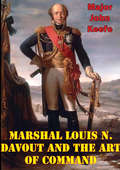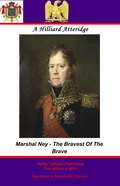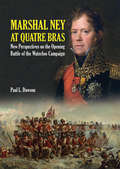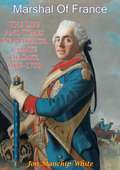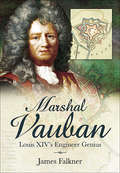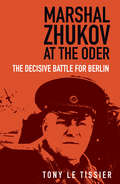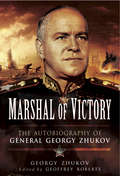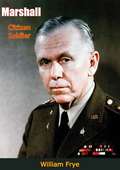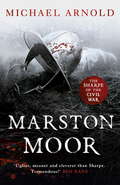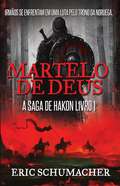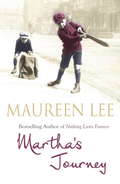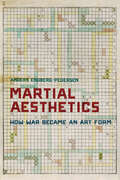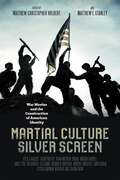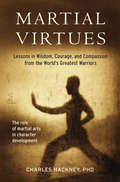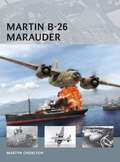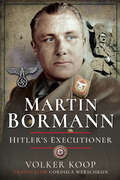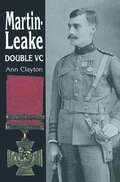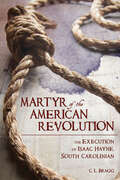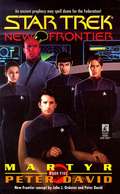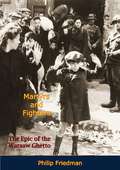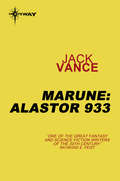- Table View
- List View
Marshal Louis N. Davout And The Art Of Command
by Major John M. KeefeThis paper involves an in-depth study of the art of command at all three levels of warfare. It examines this art through the eyes of one of Napoleon's ablest Marshals, Louis N. Davout. The paper addresses and accomplishes three primary goals. First, it defines the art of command and shows its relevance to modern day warfare. Second, the paper shows that Marshal Davout was the best of Napoleon's generals and had an art of command that rivaled the Emperor himself. Finally, the paper demonstrates how Davout was instrumental in winning the battle of Abensberg-Eckmühl.The study proves that Marshal Davout displayed an art of command at Abensberg-Eckmühl that ensured success for Napoleon during the early phases of his Austrian campaign of 1809. It does this through a detailed analysis of his actions throughout the five days of fighting from April 19 to April 23, 1809. The study then draws conclusions to help define the art of command from Davout's actions.
Marshal Ney - Bravest Of The Brave: Michel Ney, Marshal Of France, Duke Of Elchingen, Prince Of The Moskowa, 1769-1815 (1912)
by Pickle Partners Publishing Andrew Hilliard AtteridgeThis ebook is purpose built and is proof-read and re-type set from the original to provide an outstanding experience of reflowing text for an ebook reader. Few of Napoleon's Marshals have been involved in such controversy as the son of a cooper from Sarrelouis, Michel Ney. His reputation has been argued over fiercely by military historians, Bonapartists, revisionists and romantics for almost two centuries since his untimely demise at the hands of his own countrymen in the gardens of the Luxembourg. This volume paints a sympathetic picture of Marshal Ney, drawing on the memoirs of his subordinates and Général Bonnal's Vie Militaire du Maréchal Ney to combine into the best single volume biography yet published in English. Atteridge writes concisely but vividly, and does not shy away with the controversies that have dogged Ney's reputation, whilst providing a clear framework of the events. The details are accompanied by numerous maps, including excellent details on the often overlooked Battle of Hohenlinden in 1800 which secured the French Republic. From the early days of the French Republic, Ney fought fiercely and with much skill, through to the dark days of the retreat from Russia in 1812 in which he saved the remnants of the vast army Napoleon led to their destruction. His actions in the Hundred Days, for which he lost his life in a trial whose outcome was predetermined, are analyzed clearly and he deserved a better lot than he received for his efforts. Ney was a pivotal figure in an era of giants and Atteridge's book does him the justice his brave and valorous character demands. Highly recommended. Atteridge's book forms a companion to his other single volume biography of Marshal Murat and his work on the varied personalities on Napoleon's Brothers. Text taken, whole and complete, from the 1912 edition, published in London by Metheun and Co. Ltd. Original - 468 pages. Author- Andrew Hilliard Atteridge (1844-1912) Linked TOC and 8 Illustrations and 8 maps.
Marshal Ney At Quatre Bras: New Perspectives on the Opening Battle of the Waterloo Campaign
by Paul L. DawsonFought on 16 June 1815, two days before the Battle of Waterloo, the Battle of Quatre Bras has been described as a tactical Anglo-allied victory, but a French strategic victory. The French Marshal Ney was given command of the left wing of Napoleons army and ordered to seize the vital crossroads at Quatre Bras, as the prelude to an advance on Brussels. The crossroads was of strategic importance because the side which controlled it could move southeastward along the Nivelles-Namur road.Yet the normally bold and dynamic Ney was uncharacteristically cautious. As a result, by the time he mounted a full-scale attack upon the Allied troops holding Quatre Bras, the Duke of Wellington had been able to concentrate enough strength to hold the crossroads.Neys failure at Quatre Bras had disastrous consequences for Napoleon, whose divided army was not able to reunite in time to face Wellington at Waterloo. This revelatory study of the Waterloo campaign draws primarily on French archival sources, and previously unpublished French accounts, to present a balanced view of a battle normally seen only from the British or Anglo-Allied perspective.
Marshal Of France; The Life And Times Of Maurice, Comte De Saxe, 1699-1750
by Jon Manchip WhiteMAURICE DE SAXE was the brilliant adornment of a brilliant age, one of the most renowned and admired men in the Europe of his day. It is not surprising that the writing of the biography of this vivid, talented and entertaining figure should have provided the author with a genial and absorbing task.He came of extraordinary stock; the circumstances of his birth were remarkable; he was the lover of many celebrated women; he won the lifelong friendship of men of the stature of Voltaire; he aspired to a crown, and nearly became the Czar of Russia; his activities spanned a whole continent, from Paris to Dresden, from Dresden to Warsaw, from Warsaw to Moscow. Yet he was more, much more, than an energetic and flamboyant adventurer: he was acknowledged to be the outstanding general of his era, a military genius who linked the epoch of Marlborough with the epoch of Frederick the Great. He led great armies and won great victories.It is part of the purpose of this book to restore him to the pre-eminent place in social and military history to which his achievements entitle him. The study of his campaigns has proved no dutiful or dreary labour, for he was among the wittiest and most elegant military practitioners who have ever lived. There was a touch of diablerie about the manner in which he gained his spectacular triumphs that set him apart from the other great captains of his era.
Marshal Vauban: Louis XIV's Engineer Genius
by James Falkner&“[A] vivid and well written account of the life of the man who built some of the most magnificent military structures known to man.&”—Clayton Donnell, &“Fortress Archaeologist&” Sebastien Le Prestre, Marshal Vauban, was one of the greatest military engineers of all time. His complex, highly sophisticated fortress designs, his advanced theories for the defense and attack of fortified places, and his prolific work as a writer and radical thinker on military and social affairs, mark him out as one of the most influential military minds of the late seventeenth and early eighteenth centuries. Yet no recent study of this extraordinary man has been published in English. James Falkner, in this perceptive and lively new account of Vauban&’s life and work, follows his career as a soldier from a dashing and brave young cavalry officer to his emergence as a masterful military engineer. And he shows that Vauban was much more than simply a superlative builder of fortresses, for as a leading military commander serving Louis XIV, he perfected a method for attacking fortifications in the most effective way, which became standard practice until the present day. Falkner&’s new study will add significantly to the understanding of Vauban&’s achievements and the impact his work has had on the history of warfare. &“A very enjoyable read for those looking for a good, basic account of Vauban&’s career and his role in the wars of Louis XIV and of fortification more generally. Its usefulness is enhanced by various maps and reproductions of portraits of key characters and of contemporary plans of fortresses.&”—War in History
Marshal Vauban: Louis XIV's Engineer Genius
by James Falkner&“[A] vivid and well written account of the life of the man who built some of the most magnificent military structures known to man.&”—Clayton Donnell, &“Fortress Archaeologist&” Sebastien Le Prestre, Marshal Vauban, was one of the greatest military engineers of all time. His complex, highly sophisticated fortress designs, his advanced theories for the defense and attack of fortified places, and his prolific work as a writer and radical thinker on military and social affairs, mark him out as one of the most influential military minds of the late seventeenth and early eighteenth centuries. Yet no recent study of this extraordinary man has been published in English. James Falkner, in this perceptive and lively new account of Vauban&’s life and work, follows his career as a soldier from a dashing and brave young cavalry officer to his emergence as a masterful military engineer. And he shows that Vauban was much more than simply a superlative builder of fortresses, for as a leading military commander serving Louis XIV, he perfected a method for attacking fortifications in the most effective way, which became standard practice until the present day. Falkner&’s new study will add significantly to the understanding of Vauban&’s achievements and the impact his work has had on the history of warfare. &“A very enjoyable read for those looking for a good, basic account of Vauban&’s career and his role in the wars of Louis XIV and of fortification more generally. Its usefulness is enhanced by various maps and reproductions of portraits of key characters and of contemporary plans of fortresses.&”—War in History
Marshal Zhukov at the Oder: The Decisive Battle for Berlin
by Tony TissierOn 31 January 1945, in the dying months of the Second World War, the first Red Army troops reached the River Oder, barely 40 miles from Berlin. Everyone at Soviet Headquarters expected Marshal Zhukov’s troops to bring the war quickly to an end. Despite bitter fighting by both sides, a bloody stalemate persisted for two months until the Soviet bridgeheads north and south of Küstrin were united and the Nazi fortress finally fell.Marshal Zhukov at the Order is an impressively detailed account of the Nazi–Soviet battles in the Oderbruch and for the Seelöw Heights, east of Berlin. They culminated in April 1945 with the last major land battle in Europe that proved decisive for the fate of Berlin – and the Third Reich. Drawing on official sources and the personal accounts of soldiers from both sides who were involved, Tony Le Tissier has reconstructed the Soviets’ difficult breakthrough on the Oder, documenting the final death throes of Hitler’s Thousand-Year Reich.
Marshal Zhukov's Greatest Battles
by Georgi K. Zhukov Theodore Shabad Harrison E. SalisburyHistory of 4 of Zhukov's battles during WWII: The Battle of Moscow, the Battle of Stalingrad, the Battle of Kursk, and the Battle of Berlin
Marshal of Victory: The Autobiography of General Georgy Zhukov
by Geogry ZhukovThe complete and unredacted autobiography by Stalin’s star general, chronicling his many campaigns throughout WWII.At Moscow, Leningrad, Stalingrad, Kursk and Berlin—as well as virtually all the principal battles on the Eastern Front during the Second World War—Georgy Zhukov played a major role. He was Stalin’s pre-eminent general throughout the conflict, and he chronicled his brilliant career as he saw it in this essential text.Here, Zhukov reveals intriguing insights into who he was, both as a man and as a commander. He also delves into the military thinking and decision-making at the highest level of the Soviet command—making this volume essential reading for anyone studying the conflict in the east.This edition of the memoirs, which were first published in heavily censored form, features an introduction by Professor Geoffrey Roberts in which he summarizes the additional material omitted from previous editions. He also provides, in an appendix, a translation of Zhukov’s account of the 1953-7 period as well as an interview with Zhukov that has previously not been available in English.
Marshall: Citizen Soldier
by William FryeIf you think of biography as the static record of a man’s achievement, compiled during twenty or more mellowing years, William Frye’s book will have the impact of an electric shock. Marshall: Citizen Soldier is not to be leafed through idly, just as George Catlett Marshall himself cannot be regarded passively.That deceptively mild manner of his, as buck privates, brass hats and not a few politicos have discovered, only indifferently conceals a driving determination, backed by an inner steel core of moral integrity and joined with a lifetime’s habit of command.The general public has not given Marshall the excited, short-lived adulation that it has heaped upon more flamboyantly dramatic military men. But the people recognized in George Marshall the citizen’s soldier to whom they could safely entrust the most vital post in an America at war—Chief of Staff of the United States Army.The acceptance by Marshall early in 1947 of one of the greatest appointive offices in our government, that of Secretary of State, a job today of world significance, leaves no doubt either of the abilities of the man or of his devotion to the public weal. For the dearest wish of the erstwhile Chief of Staff had been a quiet retirement at the end of his Army duties.Marshall began his career in unorthodox fashion by graduating from the V.M.I. instead of West Point. Even on routine tours of duty in the Philippines, in the States and later in China he was singled out by senior officers as a young man of remarkable ability. During World War I, Marshall asked for command duty in France. His superiors rushed him abroad but they realized that Major Marshall was hard-to-get staff officer material, not slated for a regular front-line assignment.William Frye as Marshall’s biographer comes into touch with some of the knottiest questions of the war years. He does not sidestep issues and controversies; he meets them with decision.
Marston Moor: Book 6 of The Civil War Chronicles (Stryker)
by Michael ArnoldThe Sixth in The Civil War Chronicles featuring Major Stryker - 'the Sharpe of the Civil War'FIVE ARMIES FORTY-SIX THOUSAND MEN ONE CROWNTHE BIGGEST BATTLE OF THE AGE2 July 1644. Five armies converge outside York. It will be a battle for honour, glory, and the fate of three kingdoms. And it will pit two great leaders - Oliver Cromwell and Prince Rupert - directly against one another for the first time. It is a day that will change the course of history.Into the cannon fire and musket smoke marches Major Innocent Stryker, battle-scarred hero of the Royalist cause. He must not only lead his men through the bloody horror and outwit his Parliamentary enemies, but uncover foul treachery on his own side. He will need every shred of experience and determination to survive.Marston Moor will be the decisive turning point in the British Civil Wars.This is the thrilling and shocking story of that battle.
Martelo de Deus
by Eric SchumacherA história e a lenda se confundem no emocionante conto sobre a vida de Hakon Haraldsson, um menino cristão que lutou pelo Alto Assento de um reino viking. Estamos no ano de 935 d.C. e o norte vives um tempo tumultuado. O rei Harald Fairhair morreu, deixando o Alto Assento do seu reino para o seu filho assassino, Erik Bloodaxe. Para garantir a sua ascensão, Erik impiedosamente elimina todos os pretendentes ao seu trono, exceto um: o seu irmão mais novo, Hakon. Os inimigos sobreviventes de Erik enviam um navio para Wessex, onde o rei cristão Athelstan está criando Hakon. Incapaz de fugir de seu destino, Hakon retorna ao Norte Viking para enfrentar o seu irmão e reivindicar o seu direito de primogenitura, mas ele vai descobrir que a vitória exigirá sacrifícios além de seus pesadelos mais selvagens.
Martha's Journey
by Maureen LeeA powerful First World War story of a woman's quest for justice, from the bestselling author of NOTHING LASTS FOREVER and THE LEAVING OF LIVERPOOL.Liverpool 1915. Martha Rossi lives in a tenement with her husband and their five children. Despite working all the hours she can, the family don't have much to get by on. When Martha's fourteen-year-old son, Joe, proudly enlists to fight for his country just to earn his mother an extra shilling, Martha is horrified. She realises the government is turning a blind eye to the scores of young boys who are joining the army. Despite her pleas and protests, Joe is dispatched to France within weeks.Unbeknown to them all, Joe's act of selfless heroism will have huge implications for Martha and all the family. As the dreaded telegrams begin to arrive from the front in France, mothers' hearts are broken across the country. Spurred on by grief of her own, Martha Rossi begins a quest that will take her right to the doors of No. 10 Downing Street. Martha's journey there will be a tough one, but with courage and the support of her friends and family, it will be the most important undertaking of her life.
Martha's Vineyard in the American Revolution (Military)
by Thomas DresserAs an isolated island outpost, Martha's Vineyard faced some unique challenges during the American Revolution. Neutrality was maintained at the start of the war due to the impact of the British regulations on the fishing and whaling industries. While political expediency may have dominated the day, Vineyard Patriots protected their homeland against the Royal Navy and contributed to the revolutionary effort against marauding British redcoats. In 1778, two key events--one involving three young women and the second an armada of forty naval ships--crystalized the opinion of Vineyarders that they should no longer remain neutral to British incursions on the Island and, more broadly, on American soil. Join local author Tom Dresser as he reveals the unheralded contributions of islanders to the fight for freedom.
Martial Aesthetics: How War Became an Art Form
by Anders Engberg-PedersenThe twenty-first century has witnessed a pervasive militarization of aesthetics with Western military institutions co-opting the creative worldmaking of art and merging it with the destructive forces of warfare. In Martial Aesthetics, Anders Engberg-Pedersen examines the origins of this unlikely merger, showing that today's creative warfare is merely the extension of a historical development that began long ago. Indeed, the emergence of martial aesthetics harkens back to a series of inventions, ideas, and debates in the eighteenth and early nineteenth century. Already then, military thinkers and inventors adopted ideas from the field of aesthetics about the nature, purpose, and force of art and retooled them into innovative military technologies and a new theory that conceptualized war not merely as a practical art, but as an aesthetic art form. This book shows how military discourses and early war media such as star charts, horoscopes, and the Prussian wargame were entangled with ideas of creativity, genius, and possible worlds in philosophy and aesthetic theory (by thinkers such as Leibniz, Baumgarten, Kant, and Schiller) in order to trace the emergence of martial aesthetics. Adopting an approach that is simultaneously historical and theoretical, Engberg-Pedersen presents a new frame for understanding war in the twenty-first century.
Martial Culture, Silver Screen: War Movies and the Construction of American Identity
by Liz Clarke Jason Phillips Brian Matthew Jordan David Kieran Andrew Graybill Kylie A. Hulbert James Trae" Welborn III Jessica Chapman Meredith Lair Andrew C. McKevitt Richard N. Grippaldi Calvin FaganMartial Culture, Silver Screen analyzes war movies, one of the most popular genres in American cinema, for what they reveal about the narratives and ideologies that shape U.S. national identity. Edited by Matthew Christopher Hulbert and Matthew E. Stanley, this volume explores the extent to which the motion picture industry, particularly Hollywood, has played an outsized role in the construction and evolution of American self-definition.Moving chronologically, eleven essays highlight cinematic versions of military and cultural conflicts spanning from the American Revolution to the War on Terror. Each focuses on a selection of films about a specific war or historical period, often foregrounding recent productions that remain understudied in the critical literature on cinema, history, and cultural memory. Scrutinizing cinema through the lens of nationalism and its “invention of tradition,” Martial Culture, Silver Screen considers how movies possess the power to frame ideologies, provide social coherence, betray collective neuroses and fears, construct narratives of victimhood or heroism, forge communities of remembrance, and cement tradition and convention. Hollywood war films routinely present broad, identifiable narratives—such as that of the rugged pioneer or the “good war”—through which filmmakers invent representations of the past, establishing narratives that advance discrete social and political functions in the present. As a result, cinematic versions of wartime conflicts condition and reinforce popular understandings of American national character as it relates to violence, individualism, democracy, militarism, capitalism, masculinity, race, class, and empire.Approaching war movies as identity-forging apparatuses and tools of social power, Martial Culture, Silver Screen lays bare how cinematic versions of warfare have helped define for audiences what it means to be American.
Martial Virtues
by Charles HackneyMartial Virtues explores the place of the martial arts in the development of moral character. It focuses on the spiritual aspects of martial arts training, attempting to answer the question of what it means to be a good warrior.In this groundbreaking analysis, Hackney draws from the psychological literature and from the lives and experiences of admirable warriors of fact and fiction. He analyzes how the virtues of ancient and modern warriors can be developed by practicing the martial arts. Using examples from the ancient Greeks to the samurai practitioners of Bushido, from Confucius all the way to Bruce Lee. Martial Virtues scrutinizes such qualities as courage, wisdom, justice and benevolence in turn, employing the lessons of modern psychology to understand how these virtues can be cultivated within ourselves and others.
Martin B-26 Marauder
by Martyn Chorlton Adam ToobyOne of the most underrated medium bombers of the Second World War, the Martin B-26 Marauder never fully managed to shake off an underserved early reputation as a dangerous aircraft to fly. Admittedly, in inexperienced hands, the B-26 could be tricky to fly, but once mastered, proved to be one of the best in its class. The aircraft incorporated a host of both revolutionary design methods and construction techniques, never before attempted amongst American aircraft manufacturers. Peyton M. Magruder's design had its roots in a USAAC proposal dating back to March 1939 calling for a twin-engined medium bomber capable of reaching 350 mph with a 2,000lb bomb load up to a range of 3,000 miles. Deemed superior to all other designs on the table at the time, almost a 1,000 had been ordered before the aircraft first took to the air November 1940. From late 1941 the first B-26s became operational in the Pacific, followed by the Mediterranean, but it is in the European theatre that the type was most prolific. Initially serving with the 8th Air Force, the type was 'discarded' to the 9th Air Force with whom it served with great distinction for the remainder of the war. It was particularly during the Normandy Landings and later the advance beyond 'the bulge' into Germany, were the B-26s medium level tactical ability shone through.The Marauder also served with the RAF, SAAF and Free French Air Force in the Mediterranean and also as part of the little credited Balkan Air Force in support of Tito's Partisans in Yugoslavia. Sadly the B-26 was unfairly treated at the beginning of its career and even more so at the end as many of the 5,200+ aircraft built were scrapped only days after the end of the war. A great aircraft in many respects the B-26 deserves to be in a better place.
Martin Bormann: Hitler's Executioner
by Volker KoopA biography of the man who served as head of the Nazi Party Chancellery, Hitler’s personal secretary, and the monster who decided the fate of millions.Born on June 17, 1900, Martin Ludwig Bormann became one of the most powerful and most feared men in the Third Reich. An obsessive bureaucrat, it was Bormann who helped steer Hitler’s apparatus of terror so effectively that he became the clandestine ruler of Nazi Germany.After joining the Nazi Party in 1927 Bormann rose through its ranks. Indeed, by July 1933 Bormann had maneuvered himself into the position where he became the Chief of Cabinet in the Office of the Deputy Führer, Rudolf Hess. In this role Bormann gradually consolidated his power base, so that when Hess carried out his infamous flight to the United Kingdom in 1941, Bormann stepped into his shoes.As the head of the Party Chancellery, Bormann took control of the Nazi Party. By the end of 1942, he was Hitler’s deputy and his closest collaborator. With the Führer increasingly preoccupied with military matters, Hitler came to rely more and more on Bormann to handle Germany’s domestic affairs. On 12 April 1943, Bormann was appointed Personal Secretary to the Führer.Feared by ministers, Gauleiters, civil servants, judges and generals alike, Bormann identified strongly with Hitler’s ideas on racial politics, destruction of the Jews, and forced labor, and made himself indispensable as the Führer’s executioner. Cold as ice, he decided the fate of millions of people.In January 1945, with the Third Reich collapsing, Bormann returned to the Führerbunker with Hitler. Following Hitler’s suicide on 30 April, Bormann was named as Party Minister, thus officially confirming his rise to the top of the Party. Late the following day he fled from the bunker to escape the encircling Red Army; his fate remaining a mystery for many years. In October 1946 he was found guilty in absentia by the International Military Tribunal at Nuremberg and sentenced to death.Drawing heavily on recently declassified documents and files, the historian and journalist Volker Koop reveals the full story of the most faithful member of Hitler’s inner circle, an individual who, whilst little known to the German people, became the second most powerful man in the Third Reich.Praise for Martin Bormann: Hitler’s Executioner“An unbelievable monster, but people still need to know about him and what he did, here fulfilled by Volker Koop, who simply doesn't hold back.” —Books Monthly (UK)
Martin Bormann: Hitler’s Executioner
by Volker KoopA biography of the man who served as head of the Nazi Party Chancellery, Hitler’s personal secretary, and the monster who decided the fate of millions.Born on June 17, 1900, Martin Ludwig Bormann became one of the most powerful and most feared men in the Third Reich. An obsessive bureaucrat, it was Bormann who helped steer Hitler’s apparatus of terror so effectively that he became the clandestine ruler of Nazi Germany.After joining the Nazi Party in 1927 Bormann rose through its ranks. Indeed, by July 1933 Bormann had maneuvered himself into the position where he became the Chief of Cabinet in the Office of the Deputy Führer, Rudolf Hess. In this role Bormann gradually consolidated his power base, so that when Hess carried out his infamous flight to the United Kingdom in 1941, Bormann stepped into his shoes.As the head of the Party Chancellery, Bormann took control of the Nazi Party. By the end of 1942, he was Hitler’s deputy and his closest collaborator. With the Führer increasingly preoccupied with military matters, Hitler came to rely more and more on Bormann to handle Germany’s domestic affairs. On 12 April 1943, Bormann was appointed Personal Secretary to the Führer.Feared by ministers, Gauleiters, civil servants, judges and generals alike, Bormann identified strongly with Hitler’s ideas on racial politics, destruction of the Jews, and forced labor, and made himself indispensable as the Führer’s executioner. Cold as ice, he decided the fate of millions of people.In January 1945, with the Third Reich collapsing, Bormann returned to the Führerbunker with Hitler. Following Hitler’s suicide on 30 April, Bormann was named as Party Minister, thus officially confirming his rise to the top of the Party. Late the following day he fled from the bunker to escape the encircling Red Army; his fate remaining a mystery for many years. In October 1946 he was found guilty in absentia by the International Military Tribunal at Nuremberg and sentenced to death.Drawing heavily on recently declassified documents and files, the historian and journalist Volker Koop reveals the full story of the most faithful member of Hitler’s inner circle, an individual who, whilst little known to the German people, became the second most powerful man in the Third Reich.Praise for Martin Bormann: Hitler’s Executioner“An unbelievable monster, but people still need to know about him and what he did, here fulfilled by Volker Koop, who simply doesn't hold back.” —Books Monthly (UK)
Martin-Leake: Double VC
by Ann ClaytonOnly three men have ever won a bar to the Victoria Cross; but only two lived to wear the medal and bar, the other, Noel Chavasse, being awarded his bar posthumously. Of the three, the third being Charles Upham of the New Zealand Military Forces, Arthur Martin - Leake and Chavasse were non-combatants, being members of the RAMC.Born in 1874, and brought up in comfortable circumstances in rural Hertfordshire, Martin -Leake trained as a doctor and spent much of his life working for an Indian railway company; but the urge to be where he felt he was most needed, coupled presumably with a thirst for adventure, though he himself would have been too modest to admit to either, took him first to South Africa during the Boer War, where he won his first VC, then to Albania during the Balkan War of 1912-13, where his presence must surely be classified as 'outside the call of duty', and finally to Flanders, where he won the bar to his VC.Surprisingly, this is the first biography of this most remarkable man, for which Ann Clayton has been given access to all the family papers. These include hundreds of his letters, but she has also unearthed eye-witness accounts of his bravery which, typically, he was at pains to gloss over. This is indeed a thrilling story of a life lived to the full by a man who sought little for himself, but having been blessed with a fortunate birthright, only wanted to repay the debt. Ann Clayton is also the author of the widely acclaimed Chavasse: Double VC, published in 1992.
Martyr of the American Revolution: The Execution of Isaac Hayne, South Carolinian
by C. L. BraggThis military history examines the complex factors surrounding the execution of an American militia colonel in British-occupied Charleston, SC.South Carolina patriot militiamen played an integral role in helping the Continental army reclaim their state from its British conquerors. In Martyr of the American Revolution, Cordell L. Bragg, III, examines the events that set Col. Isaac Hayne into a disastrous conflict with two British officers, his execution in Charleston, and the repercussions that extended from South Carolina to the Continental Congress and the halls of British Parliament.Hayne was the most prominent American executed by the British for treason. He and his two principal antagonists, Lt. Col. Nisbet Balfour and Lt. Col. Francis Lord Rawdon, were unwittingly set on a collision course that climaxed in an act that sparked one of the war’s most notable controversies. Martyr of the American Revolution sheds light on why two professional soldiers were driven to commit a seemingly arbitrary deed that halted prisoner exchange and nearly brought disastrous consequences to captive British officers.The death of a patriot in the cause of liberty was not a unique occurrence, but the unusually well-documented events surrounding the execution of Hayne and the involvement of his friends and family makes his story compelling and poignant. Unlike young Capt. Nathan Hale, who suffered a similar fate in 1776, Hayne did not become a folk hero. Yet his execution became an international affair debated in both Parliament and the Continental Congress.
Martyr: A Novel (Star Trek: The Next Generation #5)
by Peter DavidWith the fall of the ancient Thallonian Empire, civil war threatens the planet of Zondar. The arrival of the U.S.S Excalibur is greeted with relief and celebration by the anxious populace, and Captain Mackenzie Calhoun, fresh from his cataclysmic escape form the Thallonian throneworld, is acclaimed as their prophesied savior. But one believer's messiah is another's blasphemer -- and a prime candidate for martyrdom. When Captain Calhoun is captured, Lieutenant Commander Burgoyne must find him before an alien fleet launched a holy war against the Federation!
Martyrs and Fighters: The Epic of the Warsaw Ghetto
by Philip FriedmanThe heroic Warsaw Ghetto epic that inspired "The Wall" and "Mila 18."Told by the survivors...It's the story of the most desperate battle in history against the most bitter odds. The true story of the Warsaw Ghetto: they had almost no weapons: they could not possibly win.-Print ed.“The systematic and thorough annihilation of Jewish communities, wherever found, was one of the main objectives of the ferocious doctrine of Nazism, bred on German soil. On September 1, 1939 the German army invaded Poland where the Jewish community had existed for many centuries and where three million Jews were living at the time of the invasion. Ruthless extermination of the Jews began at once and eventually reached dreadful proportions never before known in human history. To accomplish this mass annihilation more efficiently, the Nazi occupants established segregated areas, or ghettos, in many Polish cities, where the Jews were forced to live. The largest ghetto was in Warsaw, where half a million human beings were herded together in a very small area in which physical and moral conditions made life a trying experience.Although they faced inevitable deportation to death camps and gas chambers, the spirit of these free human beings was not daunted. The Jewish inhabitants of Warsaw, though eventually reduced to one-tenth of their original strength by the Nazis, were determined not to surrender; they made up their minds to exact a heavy toll from their oppressors and murderers. The Jewish insurrection in the Polish capital was a bold challenge to the Nazi tyrants—a historic manifestation of faith in freedom and in the innate rights of man against slavery, oppression and degradation of the human spirit.”-Introduction.
Marune: Alastor 933
by Jack VanceThe second of the three 'Alastor' novels, a typical Vance story of a man who has lost his memory and is sent to the world Marune in the Alastor Cluster, which is believed to be his home. Once he has recovered his memory, he goes after the enemy who has caused its loss.
